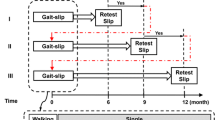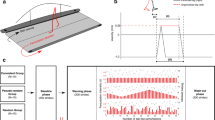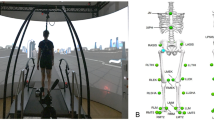Abstract
The purposes of this study were: (1) to examine the reactive control of the resultant joint moments at the lower limbs in response to a novel and unannounced slip; (2) to establish individualized forward-dynamics models; and (3) to explore personal potential by determining the operation limits of these moments at each lower limb joint, beyond which the resulting motion at this or other joints will exceed its/their normal range(s). Ten young subjects’ kinematics and kinetics, collected during regular walking and during their first exposure to a novel and unannounced slip, were randomly selected from an existing database. An inverse-dynamics approach was applied to derive their (original) resultant joint moments, which were then used as input to establish forward-dynamics models, each including an individualized 16-element foot model to simulate ground reaction force. A simulated annealing (SA) algorithm was applied to modify the original moments, so that the subsequent output (baseline) moments can closely reproduce these subjects’ recorded motion. A systematic alteration of the baseline moments was employed to determine the operation limits. The results revealed that the subjects reactively increased the hip extensor and knee flexor moments and reduced their ankle plantar flexor moments of their single-stance limb following slip onset. The “baseline” correction of the original moments can reach as much as 21% of the original moments. The analysis of the operation limits revealed that these individuals may be able to further increase their knee flexors more so than increase the hip extensors or reduce ankle plantar flexors before causing abnormal joint movement. Such systematic approach opens the possibility to properly assess an individual’s rehabilitation potential, and to identify whether this person’s strength is the limiting factor for stability training.







Similar content being viewed by others
References
Anderson, E. A., J. B. Ellis, and A. J. Weiss. Verification, validation and sensitivity studies in computational biomechanics. Comp. Methods Biomech. Biomed. Eng. 10:171–184, 2006.
Anderson, F. C. A dynamic optimization solution for a complete cycle of normal gait: an analysis of muscle function and joint contact force. PhD dissertation, University of Texas at Austin, Austin, TX, 1999.
Anderson, F. C., S. R. Goldberg, and M. G. Pandy. Contributions of muscle forces and toe-off kinematics to peak knee flexion during the swing phase of normal gait: an induced position analysis. J. Biomech. 37:731–737, 2004.
Anderson, F. C., and M. G. Pandy. Dynamic optimization of human walking. J. Biomech. Eng. 123:381–390, 2001.
Arnold, A. S., M. H. Schwartz, D. G. Thelen, and S. L. Delp. Contributions of muscles to terminal-swing knee motions vary with walking speed. J. Biomech. 40:3660–3671, 2007.
Atkinson, L. V., P. J. Harley, and J. D. Hudson. Numerical Methods with Fortran 77: A Practical Introduction. Workingham, UK: Addison-Wesley, 1989, 405 pp.
Berg, K. O., S. L. Wood-Dauphinee, J. I. Williams, and B. Maki. Measuring balance in the elderly: validation of an instrument. Can. J. Public Health 83(Suppl 2):S7–S11, 1992.
Bhatt, T., and Y. C. Pai. Can observational training substitute motor training in preventing backward balance loss after an unexpected slip during walking? J. Neurophysiol. 99:843–852, 2008.
Bhatt, T., E. Wang, and Y.-C. Pai. Retention of adaptive control over varying intervals: prevention of slip-induced backward balance loss during gait. J. Neurophysiol. 95:2913–2922, 2006.
Bhatt, T., J. D. Wening, and Y.-C. Pai. Adaptive control of gait stability in reducing slip-related backward loss of balance. Exp. Brain Res. 170:61–73, 2006.
Boone, D. C., and S. P. Azen. Normal range of motion of joints in male subjects. J. Bone Jt. Surg. 61:756–759, 1979.
Cham, R., and M. S. Redfern. Lower extremity corrective reactions to slip events. J. Biomech. 34:1439–1445, 2001.
Chao, E. Y., and K. Rim. Application of optimization principles in determining the applied moments in human leg joints during gait. J. Biomech. 6:497–510, 1973.
Chumanov, E. S., B. C. Heiderscheit, and D. G. Thelen. The effect of speed and influence of individual muscles on hamstring mechanics during the swing phase of sprinting. J. Biomech. 40:3555–3562, 2007.
Corona, A., M. Marchesi, C. Martini, and S. Ridella. Minimizing multimodal functions of continuous variables with the “Simulated Annealing” algorithm. ACM Trans. Math. Softw. 13:262–280, 1987.
de Leva, P. Adjustments to Zatsiorsky-Seluyanov’s segment inertia parameters. J. Biomech. 29:1223–1230, 1996.
Delp, S. L., F. C. Anderson, A. S. Arnold, P. Loan, A. Habib, C. John, and D. G. Thelen. OpenSim: Open-source software to create and analyze dynamic simulations of movement. IEEE Trans. Biomed. Eng. 54:1940–1950, 2007.
Ferber, R., L. R. Osternig, M. H. Woollacott, N. J. Wasielewski, and J.-H. Lee. Reactive balance adjustments to unexpected perturbations during human walking. Gait Posture 16:238–248, 2002.
Gilchrist, L. A., and D. A. Winter. A two-part, viscoelastic foot model for use in gait simulations. J. Biomech. 29:795–798, 1996.
Grabiner, M. D., T. M. Owings, and M. J. Pavol. Lower extremity strength plays only a small role in determining the maximum recoverable lean angle in older adults. J. Gerontol. A. Biol. Sci. Med. Sci. 60A:1447–1450, 2005.
Holbrook, T. L. The Frequency of Occurrence, Impact and Cost of Musculoskeletal Conditions in the United States. Chicago: American Academy of Orthopedic Surgeons, 1984.
Kuo, A. D. A least-squares estimation approach to improving the precision of inverse dynamics computations. J. Biomech. Eng. 125:864–874, 1998.
Layne, L. A., and K. M. Pollack. Nonfatal occupational injuries from slips, trips, and falls among older workers treated in hospital emergency departments, United States, 1998. Am. J. Ind. Med. 46:32–41, 2004.
Liu, M. Q., F. C. Anderson, M. G. Pandy, and S. L. Delp. Muscles that support the body also modulate forward progression during walking. J. Biomech. 39:2063–2630, 2006.
Neptune, R. R., S. A. Kautz, and F. E. Zajac. Contributions of the individual ankle plantar flexors to support, forward progression and swing initiation during walking. J. Biomech. 34:1387–1398, 2001.
Neptune, R. R., I. C. Wright, and A. J. Van Den Bogert. A method for numerical simulation of single limb ground contact events: application to heel-toe running. Comput. Methods Biomech. Biomed. Eng. 3:321–334, 2000.
Pai, Y.-C. Movement termination and stability in standing. Exerc. Sport Sci. Rev. 31:19–25, 2003.
Pai, Y.-C., and T. Bhatt. Repeated slip training: an emerging paradigm for prevention of slip-related falls in older adults. Phys. Ther. 87:1478–1491, 2007.
Redfern, M. S., R. Cham, K. Gielo-Perczak, R. Gronqvist, M. Hirvonen, H. Lanshammar, M. Marpet, C. Y. Pai, and C. Powers. Biomechanics of slips. Ergonomics 44:1138–1166, 2001.
Seth, A., and M. G. Pandy. A neuromusculoskeletal tracking method for estimating individual muscle forces in human movement. J. Biomech. 40:356–366, 2007.
Stevens, J. A., P. S. Corso, E. A. Finkelstein, and T. R. Miller. The costs of fatal and non-fatal falls among older adults. Inj. Prev. 12:290–295, 2006.
Tinetti, M. E. Performance-oriented assessment of mobility problems in elderly patients. J. Am. Geriatr. Soc. 34:119–126, 1986.
Vaughan, C. L., B. L. Davis, and C. J. O’Connor. Dynamics of Human Gait. Cape Town, South Africa: Kiboho Publishers, p. 141, 1992.
Winter, D. A. Overall principle of lower limb support during stance phase of gait. J. Biomech. 13:923–927, 1980.
Wojcik, L. A., D. G. Thelen, A. B. Schultz, J. A. Ashton-Miller, and N. B. Alexander. Age and gender differences in peak lower extremity joint torques and ranges of motion used during single-step balance recovery from a forward fall. J. Biomech. 34:67–73, 2001.
Yang, F., F. C. Anderson, and Y.-C. Pai. Predicted threshold against backward balance loss in gait. J. Biomech. 40:804–811, 2007.
Yang, F., T. Bhatt, and Y.-C. Pai. Role of stability and limb support in recovery against a fall following a novel slip induced in different daily activities. J. Biomech. 42:1903–1908, 2009.
Yang, F., and Y.-C. Pai. Correction of the inertial effect resulting from a plate moving under low-friction conditions. J. Biomech. 40:2723–2730, 2007.
Yang, F., and Y.-C. Pai. Role of individual lower limb joints in reactive stability control following a novel slip in gait. J. Biomech. 43:397–404, 2010.
Acknowledgments
This work was funded by NIH 2R01-AG16727 and R01-AG029616. The authors would like to thank Dr. Frank C. Anderson for contributing his software platform and his earlier consultation, and Debbie Espy for editing the text.
Author information
Authors and Affiliations
Corresponding author
Additional information
Associate Editor Catherine Disselhorst-Klug oversaw the review of this article.
Appendix: The Optimization Procedure
Appendix: The Optimization Procedure
Each joint activation level time history was divided into a set of independent, linearly interpolated variables or control nodes. The initiation of the control nodes for SA was the original joint moments derived from the inverse-dynamics analysis. Once the control nodes were determined, each joint moment history was reconstructed using linear interpolation (Eq. (2)). After the initiation, the forward-dynamics simulation was performed by integrating the equations of motion (Eq. (1)). The objective function (Eq. (3)) was then evaluated by comparing the output kinematics with the corresponding experimental values. Based on the evaluation, the values of control nodes and spring/damping coefficient of the visco-elastic element would be adjusted by SA in light of its acceptance/rejection criteria. This iteration was continued until the improvement in the object function became <10−3 for 500 consecutive function evaluations. The optimization-derived joint moments were the baseline moments used to investigate the operation limits.
Rights and permissions
About this article
Cite this article
Yang, F., Pai, YC. Reactive Control and its Operation Limits in Responding to a Novel Slip in Gait. Ann Biomed Eng 38, 3246–3256 (2010). https://doi.org/10.1007/s10439-010-0082-7
Received:
Accepted:
Published:
Issue Date:
DOI: https://doi.org/10.1007/s10439-010-0082-7




